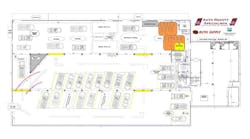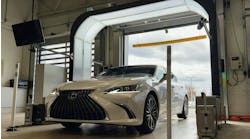I enjoy diagnostics and am constantly looking for the next challenge. I’m in my third year as a mobile technician. This business and the work we do has evolved into something I could never have imagined when I was still working in a shop and dreaming up the idea of MASS (Mobile Automotive Service Solutions).
Catching-up to the curve
Programming all makes and models was much more challenging than I anticipated. Transitioning from an aftermarket shop working on out of warranty vehicles to working on brand new vehicles that have been in a collision meant I had to immediately learn five years' worth of technology.
I wasn’t completely unfamiliar with ADAS systems, but I wasn’t really aware of how much they are tied into nearly every other electronic system on the vehicle. It is easier to think of a system that is tied to the ADAS system than one that isn’t. Consider a front radar operating adaptive cruise as it approaches a slower vehicle ahead. It may be receiving signals like wheel speed and yaw rate from ABS and airbag modules, just to name a few. At the same time, it may be outputting signals to the ABS module to apply brakes, the airbag module to lock the seatbelts, TCM to unlock the torque converter or downshift, the radio to operate an audible warning, the cluster to operate a visual warning, the PCM to control throttle angle, the BCM to operate brake lights, and maybe even the suspension controller to adjust dampening. If you think that’s impressive, check out the Audi pre sense side system which uses a radar to detect a side impact and raise the vehicle over three inches in half of a second to help absorb the collision.
With that in mind, it makes a little more sense how just about any fault can disable an ADAS system. It's crazy to think that an aftermarket radio can cause an ADAS system not to function correctly, but I've seen it with my own two eyes.
What DOESN’T require calibration?
Aftermarket radios are the least of our worries going forward. Because these systems are intertwined into so much of the vehicle, we are seeing more and more repairs that used to be simple and quick, which now require calibration. If you need to replace the A/C condenser or radiator in a 2017 Toyota Avalon, chances are it is equipped with a millimeter-wave radar sensor that will need calibrating after the repair. You might not think replacing the transmission in a 2016 Ford Transit would have anything to do with ADAS but if it is equipped with Lane Departure Warning, that Transit will need the IPMA alignment service performed.
The transmissions in those Transits have a high failure rate (ask me how I know). Is your shop performing these calibrations or at least subletting them to someone who can? The problem with our industry has always been underestimating the value and importance of technician training. ADAS systems are quickly bringing that issue to the forefront. Often, a vehicle like this Transit will be put back into service without performing the IPMA calibration because, no one at the shop was aware that it was required after replacing the transmission. You might be thinking, “well Mike that sounds like a stretch. Why would the Image Processing Module A (windshield camera) need calibrating if I'm replacing a transmission? The answer to that question can be found in service information. The challenge for technicians is that it is not at all easy to find. It is in there, even in aftermarket service information, you just have to know where to look and be thorough.
If we look up the transmission R&R procedure we won’t find “IPMA alignment” on the first page. It will take more than a few clicks to get us there. Each step is laid out in the procedure as a step. Step 1: hoist the vehicle. Step 2: Disconnect the battery. Both of these steps have procedures of their own but rather than include each individual step for hoisting the vehicle and disconnecting the battery in the transmission R&R procedure, a hyperlink is listed in the step for disconnecting the battery that will take you to that specific procedure. There are 64 steps in the removal and installation of our transmission. Of those 64 steps, 18 of them will link you to another procedure such as the R&R procedure for the battery. There are a total of 12 links because some are redundant and some are not (e.g. the starter removal procedure is linked in both the removal and installation procedure, while the link to the adaptive learning procedure will only be found in the installation procedure). One of those links will take us to the R&R procedure for the front subframe, but we still won’t find the IPMA alignment there either. There 22 steps with two links in the procedure to R&R the front subframe. One of those links takes you to the procedure for the front toe adjustment and, at the very bottom of that procedure, you will find an italicized note that reads:
“NOTE: If equipped with Lane Departure Warning (LDW) System, camera alignment is required for the lane-keeping alert and lane-keeping aid to function correctly.
Connect the scan tool and perform the IPMA camera alignment procedure. Follow the scan tool directions. General Equipment: Ford approved diagnostic tool”
To put it into perspective, if open a new browser window for each procedure, and one for each procedure listed in that procedure, and so on, you will end up with 18 windows of procedures that you will need to read in their entirety in order, to read the entire transmission R&R procedure. And, in one of the last windows, at the very bottom, is one warning and two sentences indicating the need for a safety system calibration.
Now, not everybody reads the procedures for jacking and lifting a vehicle but hopefully, we are at least reading the procedures on things like battery replacement, as more and more resets and relearns are being required once the battery is reconnected. I know I’ve been embarrassed when a customer returns with their automatic sunroof not operating properly because I forgot to read the procedure for disconnecting and reconnecting the battery. It’s just not the way we were trained to operate. In order to make a living in this industry, we needed to be efficient. I would like to blame flat-rate and that one service writer who hands us a "waiting" clutch-job, but it really doesn't matter. At the end of the day, it is up to us to make sure these procedures are being followed. Missing a sunroof-relearn is one thing but, sending a vehicle out without performing a required safety system calibration should not be acceptable practice at any repair facility. No matter how buried the procedure outlined in service-info is, or how much of a rush we are put in, it is our job to make sure that the vehicle is safe to be put back in service, when we complete any repair.
“…but Mike, are these calibrations really that important?”
Let’s get back to the Avalon with the R&R of the A/C condenser or radiator. What happens when the millimeter-wave radar is removed and reinstalled on that Toyota Avalon and, calibration is not performed? Well, let's first talk about what the millimeter-wave radar is and how it works. Radars are primarily used in adaptive cruise, autonomous braking/collision warning, and blind-spot monitoring systems. The radar units emit a beam of radio waves. The width of that beam (think "field of view") [see Fig. 1] is dependent on application i.e. a blind spot radar will emit a wide beam that allows it to detect vehicles throughout the entire blind spot, whereas a forward-facing radar may emit a tighter beam intended to only identify vehicles ahead. Once emitted, radio waves reflect off of objects and some of those reflected radio waves return to the radar unit where, they are used to measure the distance and velocity of whatever object they reflected from.
In order for the radar to determine this information, it needs to compare measurements taken, over time and compare them to a reference angle. For now, think of the reference angle as the center of the radar beam. If an object detected by the radar unit is located 31° to the left of that reference angle, and a moment later it is 59°, [See Fig. 2] it can now use that information, along with distance and velocity measurements to determine the trajectory of the object the radar has detected [See Fig. 3]. If you feel like "nerding-out," read up on the doppler effect and azimuth angles for an even better understanding of how this tech works.
Once the radar in our Avalon has identified an object, it's location, trajectory, and velocity can be calculated using the reference angle, but it will need to know the trajectory of the vehicle that the radar is mounted on (our Avalon) in order, to operate any ADAS function. For this operation, it will look at inputs from steering angle, wheel speeds, and yaw rate, to name a few. These inputs allow the system to predict the trajectory, velocity, and the vehicle’s direction of travel. Compare that data to the data of the object, identified in the radar and, “voila!” We have everything we need to operate our adaptive cruise control. Well, almost… there’s more to it than that. For example, in order for radar to know where a detected object is located in relation, to the Avalon, it must know where the radar is located on the vehicle. When we perform the millimeter-wave radar calibration on our Avalon, we are feeding the radar that information! The radar has no way of knowing it has been removed and reinstalled and is not likely installed exactly as it was, before.
“…And if we don’t calibrate that radar?”
Assuming our Avalon came into the shop with a properly operating adaptive cruise system, the radar would have calibrated and learned it’s mounted position in relation to the vehicle. In a perfect world when traveling on a straight and level road, all four-wheel speeds are the same, the steering angle sensor would read 0°, and the vehicle will travel straight forward along the vehicle centerline [See Fig. 4]. In that same perfect world, the radar would be mounted perfectly on that centerline so that the center of the radar beam (beam axis) matched the vehicle centerline. But we don’t live in a perfect world and chances are that radar wasn’t mounted perfectly center when it came in. Odds are even better than it isn't going to be mounted in the same position when it is reinstalled. This is why they must be calibrated. The radar has no way of knowing that it’s beam axis angle (consider this the angle the radar is looking) has shifted when it was removed and reinstalled and if it isn’t calibrated afterward, chances are the reference angle it is using to calculate the position of objects it detects, is not correct.
But does it really make a difference? Consider that an average long-range radar can read over 800 feet. If that radar was removed from the vehicle and reinstalled 2° off horizontally, it‘s beam axis will land 13.96 feet in the wrong direction, at a distance of 400 feet. The average width of an interstate lane is 12 feet meaning that at HALF of its useable range the radar will be “looking” in the wrong lane if the radar is only 2°off and calibration is not performed [See Fig. 5]!
A little goes a long-way
There are two things I am certain of. First, I am not capable of removing and installing a radar unit and having it end up within 2° of where it was before I touched it and second, I do not want to be in a Toyota Avalon with the adaptive cruise set at 65mph while the radar is looking at vehicles in the wrong lane!
Although LiDAR and camera imaging technology do not operate the same way as radar, the necessity for calibrating them after any service that could shift one of these components, is the same. You may be thinking that there is no way we could have shifted the IPMA camera on the windshield during the R&R of our transmission, and you would be correct. So why was the calibration necessary?
I had mentioned that the radar in our Avalon was presumably calibrated and learned. When we calibrate these systems, at least during a static calibration, we are often calibrating the component in relation to the centerline. But, what if our vehicle has a directional pull?
The camera in our Transit is looking at the lane lines and determining the position of the vehicle in relation to the center of the lane in order to operate the LDW (Lane Departure Warning) system. In addition, it is constantly trying to predict where the vehicle is going in relation to the lane markers so that it can give an audible or haptic warning to the driver, if it determines the vehicle is about to exit the lane. As I’m sure you could imagine, steering angle input is crucial to the operation of this system. Even a slight adjustment to our toe can change the tracking of our Transit which would have been learned prior to performing the alignment. The camera has no way of knowing that the vehicle was aligned. Because it may not track the way it previously did before the alignment (and that can directly affect the operation of the LDW system) , the service procedure requires the IPMA alignment to be performed after adjusting the front toe.
Our Transit and Avalon are really just the tips of the iceberg. These systems, components, and calibrations can vary drastically, from model to model. Let alone, make to make. We generally use the term calibration to define a wide variety of ADAS related procedures and, we often try and categorize calibrations as dynamic or static (with dynamic being a calibration performed while driving and a static calibration being performed in the shop using special tools). While this can be helpful, I believe it can also be misleading at times. Not all ADAS related functions require a scan tool function to perform a calibration. Just because your scan tool does not have the option for calibration or, says that there is not one, does not mean there isn’t. And, just because your scan tool shows a calibration function (even if it is a dynamic calibration), does not mean that leveling tools or special procedures are not required before performing the calibration. I often see vehicles not being calibrated because the procedure wasn’t in the scan tool. When, in reality, these components do not need a scan tool for the calibration. Instead, they have procedures requiring special tools used to measure the position and mounting angle of a component on the vehicle.
I usually field multiple calls a day asking if a calibration needs to be performed after an certain repairs. Often these are collision calls and, chances are that, just because the vehicle was not damaged anywhere near the sensor, it may need calibration as part of another service. Using Honda as an example, a camera and radar calibration are required after an SRS deployment. This means that even if just the seatbelt tensioners deploy, the radar and the windshield camera must be calibrated.
The other big misconception we need to change is the idea that if there are no codes, nothing is wrong. It is a common misconception in the glass industry that if they don’t unplug the camera no codes will set, and it will not need calibrated. That is not the case at all. These components have no way of determining that they have been removed and reinstalled and most of them will not set a code even if they are unplugged and plugged back in. This is because if they did set codes, a calibration would need to be performed every time the battery went dead. Often these systems will take many miles of driving to set codes indicating the calibration is off and that is if they will even set a code at all. I have driven plenty of vehicles with no codes that would have allowed adaptive cruise to rear end the vehicle in front if I didn’t intervene as well as vehicles with no codes that activate the brakes when approaching oncoming traffic in the opposing lane on a two lane road. Often these systems will eventually code but it may take multiple instances of unsafe operation before the system is disabled and codes are set. No codes does not mean no calibration!
Research is a necessity…The one common-trait among ADAS systems is that procedures vary
The only way to find this information is to be thorough in researching each service you are performing. If you are a technician thinking, "there's no way I can afford to spend 15 minutes researching every service that I perform and still make flat rate." then you should probably let your shop owner and service writers read this article. ADAS is and will continue to be one of the main driving factors that change the repair industry. The gap between shops that are thriving and those that are struggling is growing wider every day and keeping up to date with technology and training is guaranteed to keep you on the right side of that gap.


